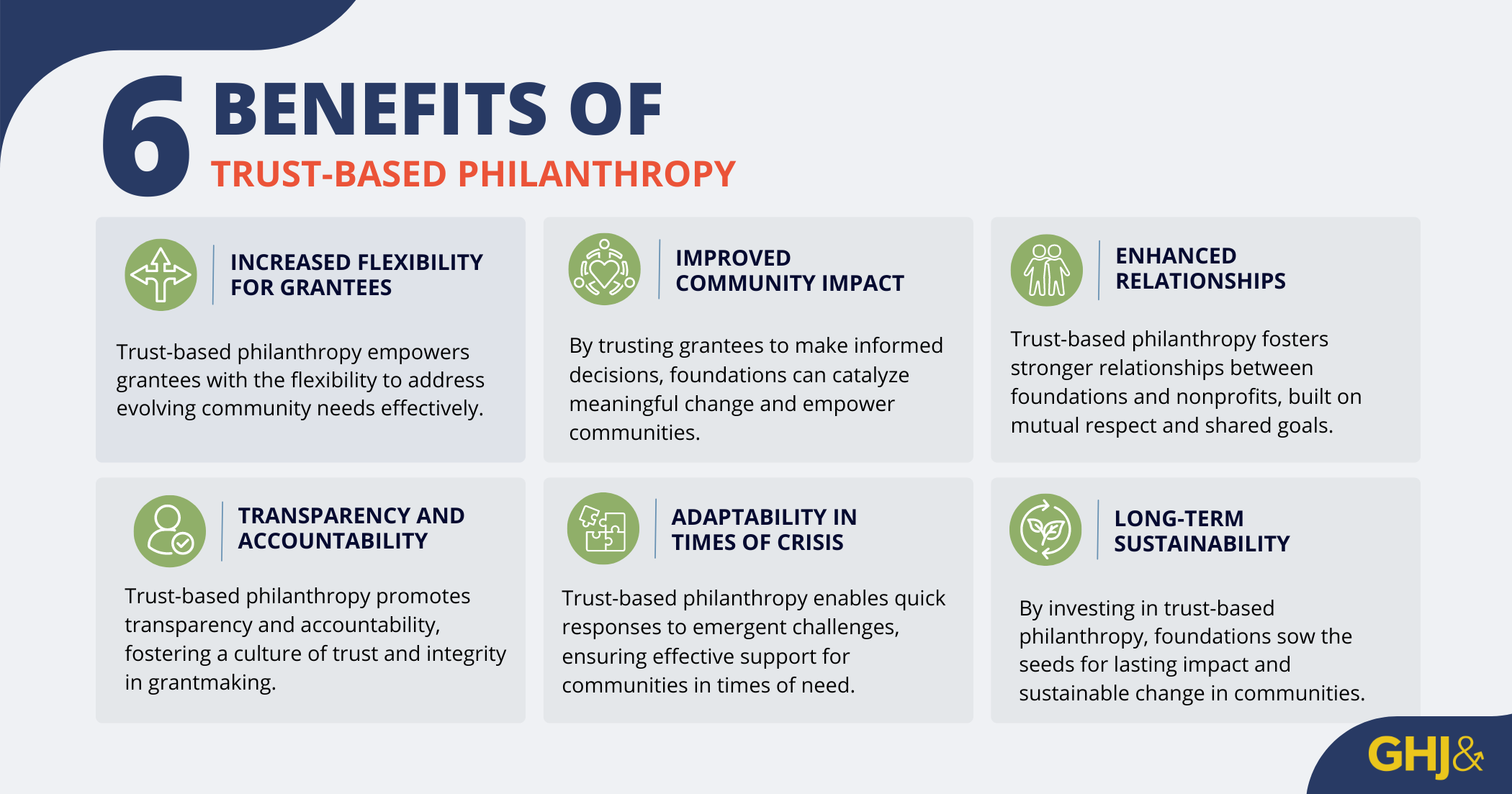Private foundations aim to make a meaningful impact by collaborating with nonprofits on the front lines of change — trust-based philanthropy (TBP) takes this partnership to the next level.
WHAT IS TRUST-BASED PHILANTHROPY?
The Trust-Based Philanthropy Project shares the following actions that foundations should take to embrace TBP:
- Give multi-year unrestricted funding so grantees can assess their own needs and allocate resources where they are most needed.
- Do independent research on their funding landscape to vet potential grantees and seek out organizations beyond their usual circles.
- Simplify paperwork and opt for a relational approach that helps funders gain a deeper understanding of the work.
- Be transparent and responsive to set the tone for a granter-grantee relationship rooted in mutual trust and responsibility.
- Solicit feedback and consider TBP a constantly evolving process to ensure a positive grantee experience.
- Offer support beyond dollars to bolster leadership, capacity and organizational health.
"It is an area within the industry where we are seeing gaining attention, especially since the pandemic," says GHJ Audit Manager Melinda Katayama. "Historically, we saw private foundation clients giving mostly restricted and project-based grants. Unrestricted needs of the grantees were growing, and the fundings are slowly catching up."
TRUST-BASED PHILANTHROPY: MORE THAN A TREND
During the pandemic, grant funds committed for specific program areas were superseded by greater needs stemming from pandemic challenges. Many private foundations chose to trust their grantees to use funds in a way that would have more impact on the community.
But this giving philosophy existed long before COVID.
“The Ralph M. Parsons Foundation has implemented several trust-based guiding principles that align with us as a foundation. For example, we have a long history of providing unrestricted general operating support, which we understand to be vital to the long-term health of our nonprofit partners. This type of funding provides the maximum flexibility and underscores our trust in grantees to make the best decisions for their own organizations." says Nicole Larsen, Director of Grants Administration at The Ralph M. Parsons Foundation.
Rather than being prescriptive, the Foundation believes that nonprofits know what is needed to do their best work in support of the organization's mission. The grantee is in the best position to determine whether they need general operating, program or capital support. However, private foundations are responsible for implementing best practices to mitigate risk while giving their grantees the flexibility they need.
ALIGN TRUST-BASED PHILANTHROPY PRACTICES WITH A FOUNDATION’S VALUES
The first step to practicing lasting TBP is to have alignment among board members, staff and other stakeholders. This may be a culture shift, so start by identifying the driving forces motivating the foundation to consider TBP.
"Have conversations with stakeholders about the foundation's risk factors before transitioning to trust-based philanthropy, no matter how much you have already begun to implement these practices in your grantmaking to ease the transition," Melinda recommends.
Although TBP is generally associated with unrestricted funding, this does not necessarily mean that other types of grant support are not trust-based — private foundations that have built-in grant restrictions can incorporate TBP’s principles while still staying aligned with their mission.
"There are many ways foundations can build trusted relationships with grantee partners that are mutually rooted in shared mission and values. Whether funding is unrestricted or restricted to a specific program that is impactful, the funding relationship can still be one marked by trust and partnership." explains Katherine Bonalos, Director of Grants and Initiatives at The Ralph M. Parsons Foundation.
ALLOW FOR TRANSPARENCY AT ALL STAGES
TBP involves transparency on both sides of a funder-grantee relationship. In addition to trusting nonprofits to spend the money as they see fit, foundations should also keep an open conversation with grantees and adjust their processes based on feedback.
When transitioning to TBP, Melinda recommends starting in familiar spaces: Target prior grantees for whom the organization has already built the rapport.
"You have already worked with those entities and built a level of confidence,” Melinda explains. “You can expand your foundation's new TBP strategies to a greater population once you have worked out the kinks in the processes."
TBP also involves two-way feedback processes for applicants and grantees. Start during the application process and continue throughout the reporting processes so that any issues are addressed in a timely manner.
Building positive relationships starts even before a nonprofit becomes a grantee.
Be transparent and have conversations with declined applicants about what might make them more successful with future applications — whether through the foundation or other funders. This feedback may help them improve their chances of getting grants in the future or look elsewhere for funders who are better aligned with their missions.
Incorporate one-on-one conversations with grantees to develop personal relationships. At the Ralph M. Parsons Foundation, every grantee has checkpoints for feedback during all stages, from letter of inquiry (LOI) and full proposal to reporting.
When incorporating any changes to grantmaking processes, be sure to make incremental shifts. Taking the time to build smart processes can mitigate the risk of launching a new TBP endeavor.
"Go slowly and ask for feedback along the way," Nicole advises. "You probably have a goal in mind. Are you really achieving that aim or are you having unintended consequences come up that you did not anticipate?"
The Ralph M. Parsons Foundation conducts anonymous grantee surveys every three years to benchmark themselves against similar funders. As part of this effort for ongoing improvement, they switched from paper applications to online forms to make it easier for grantees to respond. They also implemented an electronic payment process to ensure money moves swiftly to the nonprofit once the board makes its decision and grant agreements are signed.
BALANCE DUE DILIGENCE WITH A CUSTOMER-CENTRIC APPROACH
It is possible to perform a foundation's due diligence holistically while still being rigorous. The Ralph M. Parsons Foundation has crafted a grantee-friendly approach that reviews financial reports, governance, leadership, program strategies and impact as well as other areas to better understand grantee partners and build a trusting relationship. Ultimately, the goal is to help the Foundation achieve its own mission and provide the right support for the nonprofit.
When reviewing financial reports with the grant application, assess the overall business model and look for trends over time. Understand how the organization is sustaining its work financially. It is also important to find out who else is in their funding mix and determine how an additional private foundation is positioned to help.
Review important areas such as the nonprofit's leadership and governance structure. Learn how board members give their time, talent and resources. Discuss the current composition and any recruitment goals. Finally, take a look at the programmatic impact.
Even while evaluating all of these criteria, foundations can implement TBP principles by doing so in a spirit of inquiry, rather than judgment.
"We come to conversations with a posture of listening and partnership, trying to understand what the real needs are and how philanthropy can help," Katherine explains.
WEIGH RISKS AND REWARDS
TBP helps foundations navigate external challenges, including different economic environments. If anything, times of economic uncertainty and volatility underscore the importance of TBP.
Ultimately, TBP can reduce the administrative burden from nonprofits, which makes grant funding more accessible to smaller organizations and frees up time for them to focus more on their impactful work. But it also gives funders less control over how resources are allocated, which can make the transition challenging. This transition can introduce risks without the traditional safeguards:
- With less oversight on how funding is applied, there is an inherent risk of misallocation or fraud.
- Since funds are not earmarked for a specific purpose, measuring the impact of funding is more complex.
- Although TBP aims to equalize the power dynamic between funders and grantees, the power dynamic remains and this shift can create tension.
As previously mentioned, an effective TBP approach requires due diligence on the funder’s part. Funders who are concerned about TBP should consider how certain actions can minimize these risks.
“Because we conduct rigorous due diligence, we believe that we have minimized any perceived risk in our grantmaking. We have also developed relationships with our grantees over time that allow us to have authentic and transparent conversations should changes arise during the course of a grant term.” Nicole says.
| GHJ’s Risk Management for Private Foundations Series: Navigating Challenges and Seizing Opportunities dives deep into the risks that private foundations face and offers practical solutions across a spectrum of areas including automation, cybersecurity and new giving strategies. Gain insights into implementing new ideas, ensuring compliance and exploring innovative partnerships to enhance impact. Learn more. |



